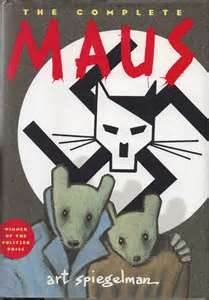 In my upcoming practicum, I will be teaching Art Spiegleman’s graphic novel, Maus. Unlike many graphic novels which often focus on fantasy, Maus is a novel in which the author, Spiegleman, retells his father’s story as a Holocaust survivor. Given the delicate nature of the subject and the fact that it will be taught to a grade nine class with little prior knowledge of the Holocaust, it is of the utmost importance to teach the novel in a thoughtful and constructive manner. As such, my project aims to explore which methods and strategies are most effective for teaching the Holocaust so that students not only understand the social, political, and religious conditions which lead to the atrocity, but also the key themes of discrimination, survival, and family. (There are more themes, but for simplicity…) Additional issues that need to be explored include ways in which to present historical material: emotionally, or factually, as well as which supplementary materials to include.
In my upcoming practicum, I will be teaching Art Spiegleman’s graphic novel, Maus. Unlike many graphic novels which often focus on fantasy, Maus is a novel in which the author, Spiegleman, retells his father’s story as a Holocaust survivor. Given the delicate nature of the subject and the fact that it will be taught to a grade nine class with little prior knowledge of the Holocaust, it is of the utmost importance to teach the novel in a thoughtful and constructive manner. As such, my project aims to explore which methods and strategies are most effective for teaching the Holocaust so that students not only understand the social, political, and religious conditions which lead to the atrocity, but also the key themes of discrimination, survival, and family. (There are more themes, but for simplicity…) Additional issues that need to be explored include ways in which to present historical material: emotionally, or factually, as well as which supplementary materials to include.
In order to explore this issue, I intend to read and review a number of scholarly articles and book chapters which focus specifically on teaching Holocaust literature. Through this research I hope to create a theoretical and practical framework for a successful unit plan, which will include lesson examples to demonstrate the shift from theory to praxis. In all likelihood, the research will show that successful teaching of the Holocaust through literature requires incorporating additional first-person literary accounts, film, primary documents and artifacts, as well as survivor testimony, if available.
4 replies on “Strategies and Methods for Teaching Holocaust Literature”
Hi Ashlee,
This is a complex and worthwhile topic to explore. I wonder if it might be useful to consider the notion of “holocaust” more broadly before leading into the question of the Holocaust and _Maus_. What are the conditions — political, social, religious, etc. — that lead to such human atrocities? Where are those conditions at play in the present day? What factors might make it less likely for such events to occur? What is it about the Holocaust that keeps it in the public imagination while other holocausts are buried in history?
Teresa
Ashlee, this sounds like a really meaningful and promising unit. I haven’t read Maus yet, but it’s definitely on my list, and maybe one day I’ll be able to teach it myself. Hopefully I can learn a thing or two (or several?) from your project.
Reading your proposal and Teresa’s comment on the way the Holocaust has remained one of the most powerful and reverberating examples of atrocity in modern history reminded me of a video I saw a while ago of Holocaust Remembrance Day in Israel. It’s pretty powerful: https://www.youtube.com/watch?v=OeozUSWdoQA
– Allison
After careful consideration and an abundance of reading, I have decided to shift my focus.
Although methods and strategies may still surface in my inquiry, I am instead going to focus on the process of othering throughout the Holocaust.
Specifically, how the Nazis created an Us versus Them mentality that subsequently led to the extermination of 6 million people. I intend to explore administrative policies as well as the power of propaganda, in the form of advertisements, film, and writing.
Ashley,
I like how you’ve decided to focus your topic – the process of othering is important both to the Holocaust and still today. The idea that prejudice and hate can be constructed through our lack of knowing about someone who is so different and foreign from ourselves is a concept that high school kids can really relate to. Us versus Them is also clearly important in Canadian history – I am thinking specifically about Japanese internment, but I am sure there are many other examples too.
You might also be interested in looking at Canada’s reaction to taking in the Jews fleeing Europe – see book “None is too many”. You’ll notice that Mackenzie King did not allow Jews to seek asylum in Canada — Canadian leadership during the second world war also saw Jews as others. too foreign from them to be saved. Is the same thing still going on now in Canada with other refugees seeking asylum from other mass murders and genocide in the present?
Looking at propaganda is clearly an excellent gateway for Maus as the model for the cat, mouse, pig, etc. caricatures in the graphic novel are clearly modelled after the stereotypical images of Jews put forth during WWII persecution. Great angle that I’m sure your students will find very interesting and easy to connect to. Are there any present-day propaganda that might help students better understand just what the brainwashing purpose of this tool is? [for some reason, I’m thinking advertisement and exaggerated media campaigns, but I’m not sure that that’s at all related to the angle you are taking this..].
Excited to read the final product!
Ilana